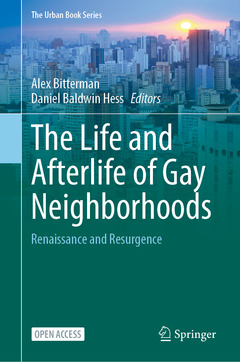The Life and Afterlife of Gay Neighborhoods, 1st ed. 2021 Renaissance and Resurgence The Urban Book Series
Coordonnateurs : Bitterman Alex, Hess Daniel Baldwin

This open access book examines the significance of gay neighborhoods (or ?gayborhoods?) from critical periods of formation during the gay liberation and freedom movements of the 1960s and 1970s, to proven durability through the HIV/AIDS pandemic during the 1980s and 1990s, to a mature plateau since 2000. The book provides a framework for contemplating the future form and function of gay neighborhoods. Social and cultural shifts within gay neighborhoods are used as a framework for understanding the decades-long struggle for LGBTQ+ rights and equality.
Resulting from gentrification, weakening social stigma, and enhanced rights for LGBTQ+ people, gay neighborhoods have recently become ?less gay,? following a 50-year period of resilience. Meanwhile, other neighborhoods are becoming ?more gay,? due to changing preferences of LGBTQ+ individuals and a propensity for LGBTQ+ families to form community in areas away from established gayborhoods. The current ?plateau? in the evolution of gay neighborhoods is characterized by generational differences?between Baby Boom pioneers and Millennials who favour broad inclusivity?signaling various possible trajectories for the future ?afterlife? of these important LGBTQ+ urban spaces.
The complicating impacts of the COVID-19 pandemic provides a point of comparison for lessons learned from gay neighborhoods and the LGBTQ+ community that bravely endured the onset of the HIV/AIDS pandemic.
This book will be of interest to students and scholars in various disciplines?including sociology, social work, anthropology, gender and sexuality, LGTBQ+ and queer studies, as well as urban geography, architecture, and city planning?and to policymakers and advocates concerned with LGBTQ+ rights and social justice.
Part I: Introduction.- Who are the people in your gayborhood? Understanding population change and cultural shifts in LGBTQ+ neighborhoods.- Part II: Context and composition.- Breaking down segregation: Shifting geographies of male same-sex households within desegregating cities.- A queer reading of the United States census.- Why gayborhoods matter: The street empirics of urban sexualities.- Part III: Identity and evolution.- The rainbow connection: A time-series study of rainbow flag display across nine Toronto neighborhoods.- Wearing pink in Fairytown: The heterosexualization of the Spanish town neighborhood and carnival parade in Baton rouge.- A tale of three villages: Contested discourses of place-making in Central Philadelphia.- Are “Gay” and “Queer-friendly" neighbourhoods healthy? Assessing how areas with high densities of same-sex couples impact the mental health of sexual minority and majority young adults.
Alex Bitterman, MArch, PhD, is Professor and Chair of Architecture and Design at Alfred State University of New York in Alfred, New York and a fellow of the New York State Council for the Humanities. Bitterman is founding editor of Multi: The Journal of Diversity in Design and a member of the editorial board of Critical Studies in Men's Fashion, published by Intellect.
Daniel Baldwin Hess, PhD, is Professor and Chair of Urban Planning at the University at Buffalo, State University of New York. He is co-editor of the journal Town Planning Review and is co-editor of Housing Estates in Europe: Poverty, Ethnic Segregation, and Policy Challenges (Springer, 2018) and Housing Estates in the Baltic Countries: The Legacy of Central Planning in Estonia, Latvia, and Lithuania (Springer, 2019).
Together, the two co-editors have expertise in urban geography, city planning, architecture, urban identity, morphology and design, social exclusion, segregation, and inequity. Hess and Bitterman are authors of more than a dozen articles about gay neighborhoods including: “Effects of Gentrification and Real Estate Market Escalation on Lesbian and Gay Neighborhoods” (Hess, 2018, Town Planning Review); “Rainbow diaspora: the emerging renaissance of gay neighbourhoods.” Bitterman, 2020, Town Planning Review); “Gay Ghettoes Growing Gray: Transformation of gay urban districts across North America reflects generational change” (Bitterman and Hess, 2016, Journal of American Culture); “For Many Gay Men, the Current Pandemic Is Triggering HIV/AIDS Trauma” (Bitterman, 2020, The Advocate); “Will Gay and Lesbian Neighborhoods Resurge?” (Bitterman and Hess, 2016, Washington Blade); “The Queer-normative Influence Towards an Inclusive and Multisthetic Transformation in Men’s Fashion” and “Getting Beyond the Fear of Queer: The transition from gender-specific fashion to inclusive style” (Bitterman, 2016, Critical Studies in Men's Fashion).
Date de parution : 03-2021
Ouvrage de 427 p.
15.5x23.5 cm
